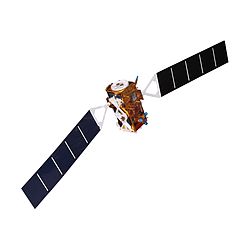Sentinel-3C
Appearance
 Vector drawing of the Sentinel-3 | |||||||||||||||||
| Mission type | Earth observation | ||||||||||||||||
|---|---|---|---|---|---|---|---|---|---|---|---|---|---|---|---|---|---|
| Operator | ESA · EUMETSAT | ||||||||||||||||
| Website | Sentinel-3 (ESA) | ||||||||||||||||
| Mission duration | Planned: 7 years | ||||||||||||||||
| Spacecraft properties | |||||||||||||||||
| Spacecraft type | Sentinel-3 | ||||||||||||||||
| Bus | Prima | ||||||||||||||||
| Manufacturer | Thales Alenia Space | ||||||||||||||||
| Launch mass | 1,250 kg (2,756 lb)[1] | ||||||||||||||||
| Dry mass | 1,150 kg (2,535 lb)[2] | ||||||||||||||||
| Dimensions | 3.9 × 2.2 × 2.2 m (12.8 × 7.2 × 7.2 ft)[1] | ||||||||||||||||
| Power | 2,300 watts[2] | ||||||||||||||||
| Start of mission | |||||||||||||||||
| Launch date | 2026 (planned) | ||||||||||||||||
| Rocket | Vega-C | ||||||||||||||||
| Launch site | Kourou, ELV | ||||||||||||||||
| Contractor | Avio | ||||||||||||||||
| Orbital parameters | |||||||||||||||||
| Reference system | Geocentric | ||||||||||||||||
| Regime | Sun-synchronous | ||||||||||||||||
| Transponders | |||||||||||||||||
| Band | S band (TT&C support) X band (science data) | ||||||||||||||||
| Bandwidth | S band: 64 kbit/s uplink, 1 Mbit/s downlink X band: 2 × 280 Mbit/s | ||||||||||||||||
| |||||||||||||||||
Sentinel-3C is a future European Earth observation satellite dedicated to oceanography which is expected to launch in 2026.[3][4] It is part of the Copernicus Programme, and the third of four planned Sentinel-3 satellites (after Sentinel-3B, launched on 16 February 2018).[5][6][7][8][9][10]
See also
[edit]References
[edit]- ^ a b "Copernicus: Sentinel-3". eoPortal. European Space Agency. Retrieved 25 April 2018.
- ^ a b "Satellite: Sentinel-3B". World Meteorological Organization. Retrieved 25 April 2018.
- ^ "Sentinel-3 | CNES". cnes.fr. Archived from the original on 20 July 2025. Retrieved 19 October 2025.
- ^ "À Cannes, Thales Alenia Space prépare le futur de la surveillance des océans avec Sentinel-3D". Tribuca.net (in French). 20 October 2025. Retrieved 19 October 2025.
- ^ "Sentinel 3A, 3B, 3C, 3D". Gunter's Space Page. Retrieved 19 October 2025.
- ^ "Sentinel-3C | Vega C | Next Spaceflight". nextspaceflight.com. Retrieved 19 October 2025.
- ^ "Sentinel-3". www.esa.int. Retrieved 19 October 2025.
- ^ "Facts and figures". www.esa.int. Retrieved 19 October 2025.
- ^ "Search". www.esa.int. Retrieved 19 October 2025.
- ^ "Launches secured for five Sentinel satellites". www.esa.int. Retrieved 19 October 2025.
External links
[edit]- Sentinel-3 program website by ESA
- Sentinel-3 website by the Copernicus Programme
- Real-time orbital tracking - uphere.space
- Sentinel-3C and Sentinel-3D side by side

